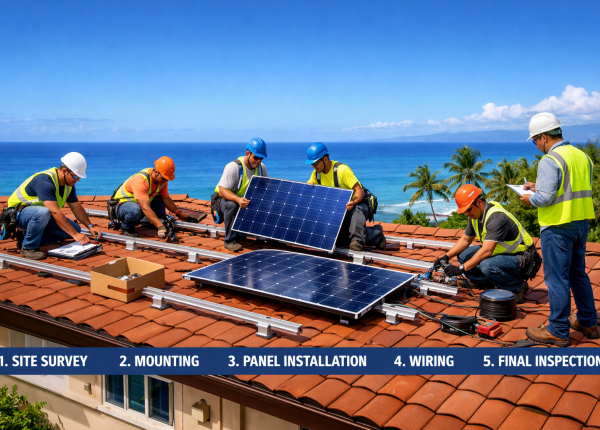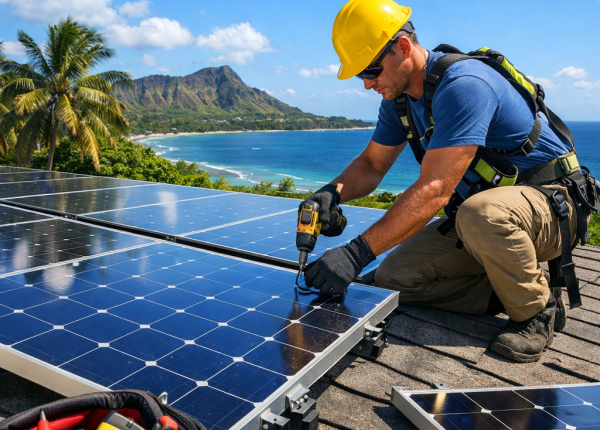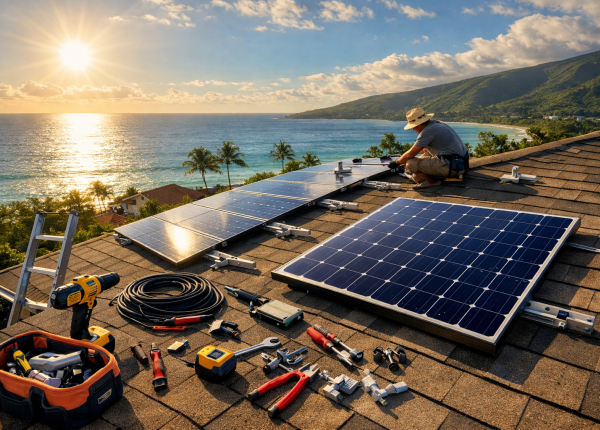Solar Energy Pros and Cons in Hawaii
Weighing the Bright Side and the Shade of Solar Power
Hawaii is blessed with abundant sunshine, making solar energy seem like a no-brainer for residents and businesses alike. Yet, while the appeal of harnessing free, clean energy from the sun is undeniable, it’s not without its challenges. From upfront costs to maintenance and storage concerns, understanding solar energy pros and cons is crucial before making the switch.
In this article, we’ll break down the pros and cons of solar energy in Hawaii—helping you make a confident, informed decision about whether solar fits your lifestyle, budget, and long-term goals.
By the end, you’ll know:
- The real costs and savings potential of solar power in Hawaii.
- The environmental and financial trade-offs of going solar.
- How to decide if solar energy is the right investment for your home or business.
Let’s dive in and explore what are the pros and cons of solar energy—both the sunny benefits and the cloudy drawbacks.
Understanding Solar Energy in Hawaii’s Unique Environment
Solar energy works by converting sunlight into electricity using photovoltaic solar energy systems. In Hawaii, where the average sunshine exceeds 270 days a year, this renewable energy source has huge potential. But while solar might seem like a perfect match for the islands, Hawaii’s geography, economy, and infrastructure introduce unique factors worth considering.
Here’s why solar power matters so much in Hawaii:
- High energy costs: Hawaii has some of the highest electricity rates in the U.S.
- Sustainability goals: The state aims for 100% renewable energy by 2045.
- Abundant sunlight: Ideal conditions make solar power highly efficient year-round.
However, installing solar in Hawaii also means dealing with:
- High upfront costs for equipment and installation.
- Grid limitations and interconnection delays on some islands.
- Maintenance challenges in coastal climates due to salt and humidity.
In short, renewable energy and solar or wind pros and cons vary across regions, but for Hawaii, the balance comes down to environmental benefits, financial gains, and practical realities.
The Core Solar Energy Pros and Cons Explained
Understanding the pros and cons of solar energy helps homeowners and business owners make smarter, data-backed decisions about clean energy investments.
Financial Savings with Solar Energy in Hawaii
One of the most significant advantages of solar energy is the potential for long-term cost savings. With electricity rates averaging over $0.40 per kWh, solar panels can drastically reduce utility bills. Homeowners who invest in solar energy for homes pros and cons often find that systems pay for themselves within 5–8 years, depending on system size and usage.
Why it matters:
- Lower monthly electricity costs.
- Increased home resale value.
- Eligibility for federal tax credits and local incentives.
Pro Tip: Check Hawaii’s solar tax credit programs—they can cover up to 35% of your system cost. For more details, visit Hawaiian Electric or Energy.gov.
Environmental Impact and Carbon Reduction Benefits
Switching to solar power dramatically reduces your carbon footprint. Unlike fossil fuels, solar panels produce zero emissions once installed.
Why it matters:
- Contributes to Hawaii’s 2045 clean energy goal.
- Reduces dependency on imported oil.
- Supports a more sustainable island ecosystem.
Solar panels generate clean energy silently, without pollutants, making them one of the most eco-friendly technologies available. If you’re curious about environmental pros and cons of solar energy, check insights from National Geographic and Forbes.
Dependence on Weather and Limited Storage Capacity
While Hawaii enjoys plenty of sunshine, cloudy days can impact production. Without a battery storage system, solar energy efficiency drops significantly at night or during storms.
Challenges include:
- Inconsistent energy generation.
- High battery storage costs.
- Need for a reliable grid connection.
Pro Tip: Investing in a PV storage solution such as Alternate Energy Hawaii’s battery systems can stabilize energy supply during outages or overcast days.
Upfront Costs and Financial Barriers to Installation
The initial cost of solar panels in Hawaii can range from $15,000 to $30,000, depending on system size. Although financing and incentives reduce this burden, the upfront investment remains a deterrent for many households.
Common misconceptions:
- “Solar panels are too expensive to be worth it.”
→ In reality, long-term savings often outweigh costs after a few years. - “You need to pay all upfront.”
→ Many installers offer payment plans, leases, and solar loans.
If you’re considering installation, explore Alternate Energy Hawaii’s photovoltaic solutions for flexible financing and design options.
Maintenance, Durability, and Coastal Weather Factors
Solar panels are durable, but Hawaii’s tropical environment introduces salt corrosion, humidity, and occasional volcanic dust that can affect performance.
Maintenance tips:
- Clean panels regularly to maintain efficiency.
- Use corrosion-resistant materials in coastal areas.
- Schedule annual professional inspections.
Proper maintenance ensures your system can last 25+ years, providing clean power long after it pays for itself. Explore related services like energy-efficient air conditioning, solar water heating, and roofing to complement your solar investment.
Practical Applications and Real-Life Solar Use Cases in Hawaii
Solar energy powers a wide variety of applications across Hawaii—from residential homes to luxury resorts and government buildings.
- Residential homeowners in Oahu: Families have cut electricity bills by up to 70%, achieving complete energy independence with battery backups.
- Commercial resorts in Maui: Large-scale solar installations have helped hotels reduce annual energy costs by over $200,000, while showcasing sustainability to eco-conscious travelers.
- Off-grid cabins in the Big Island: Remote properties use hybrid setups combining solar, batteries, and backup generators for reliable energy where grid access is limited.
These examples highlight pros and cons about solar energy in action—it’s not just an environmental decision, but a financial and lifestyle choice.
Best Practices and Common Mistakes When Going Solar
Transitioning to solar energy is a major decision. Here’s how to do it right—and what pitfalls to avoid.
- Get a professional site assessment. Have an expert evaluate your roof condition, angle, and shading.
- Research local incentives thoroughly. Hawaii offers excellent rebates—missing them can cost you thousands.
- Don’t undersize or oversize your system. Proper sizing prevents inefficiency.
- Maintain your panels regularly. Clean and inspect every 6–12 months.
- Monitor your system performance. Use inverter apps to track daily output.
Pair your solar setup with electric vehicle charging solutions for even greater energy independence.
Is Solar Energy Worth It in Hawaii?
When weighing pros and cons of using solar energy, most experts agree: the benefits outweigh the drawbacks. While upfront expenses exist, the long-term payoff in savings, sustainability, and self-sufficiency makes solar an excellent investment.
For most homeowners and businesses, going solar means embracing independence from rising utility rates while contributing to Hawaii’s renewable energy future. To learn more, contact Alternate Energy Hawaii for expert guidance and customized installations.
Frequently Asked Questions About Solar Energy Pros and Cons in Hawaii
1. Is solar energy worth it in Hawaii?
Yes. With Hawaii’s high electricity rates and abundant sunshine, most systems pay for themselves within 5–8 years through savings and tax credits.
2. What are the main disadvantages of solar energy?
The main cons of solar energy include high upfront costs, dependence on sunlight, and maintenance needs in humid or coastal areas.
3. Can solar panels work during cloudy or rainy days?
Yes, but efficiency drops by 10–25%. Energy stored in batteries or drawn from the grid compensates for this shortfall.
4. How long do solar panels last in Hawaii?Most panels last 25–30 years with proper maintenance. Regular cleaning is essential in tropical climates.
5. Are there government incentives for solar in Hawaii?
Absolutely. Hawaii residents can benefit from the Federal Investment Tax Credit (ITC) and state solar tax credits, significantly reducing installation costs. You can explore detailed resources on EnergySage and Energy.gov.


